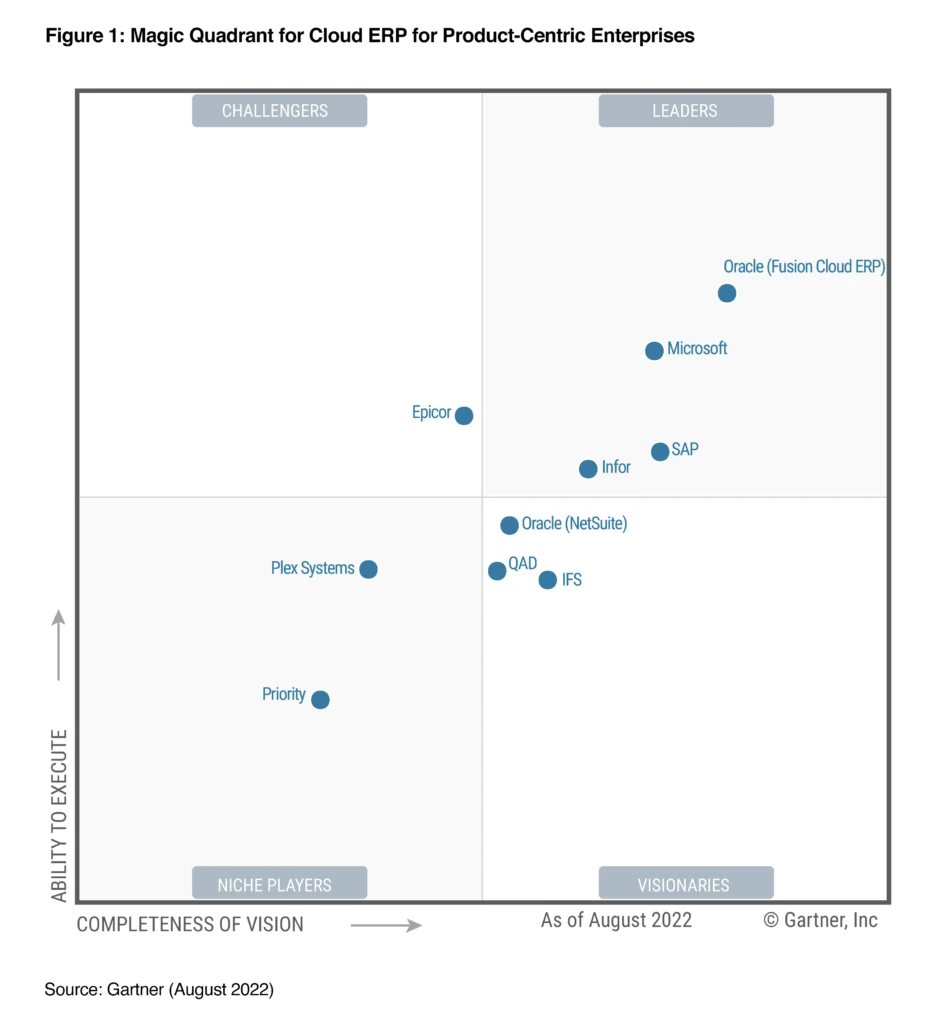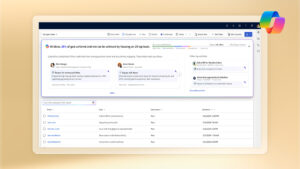
Microsoft recognized as a Leader in the 2022 Gartner® Magic Quadrant™ for Cloud ERP for Product-Centric Enterprises
We are excited and honored that Gartner has recognized Microsoft as a Leader in their 2022 Magic Quadrant™ for Cloud ERP for Product-Centric Enterprises.* This evaluation of Microsoft was based on specific criteria that analyzed our overall Completeness of Vision and Ability to Execute. This is the second year in a row we’ve been recognized as a Leader. As Product-Centric enterprise customers transition their mission-critical enterprise resource planning (ERP) processes to the cloud, we believe they look to recognized vendors for the technology to transform and realize business value. We’re honored to be recognized in this space.

An integrated enterprise ERP solution
Both Dynamics 365 Supply Chain Management and Dynamics 365 Finance offer organizations the standard capabilities they expect in an ERP solution but delivered on a modern, open, and cloud-based architecture that empowers composability and scalability. These solutions can work as stand-alone products or together as an integrated, extensible solution—giving businesses the flexibility to work the way they want.
Building a Leader
At the heart of our vision is the relentless desire to empower organizations to enable a resilient and sustainable supply chain, and it is through this vision and dedication that we have built a Leader. Let’s explore the qualities we believe put us in this category.
Cloud-native ERP integrated with the Microsoft technology stack
Dynamics 365 is a cloud-native application that runs, and was built on, Microsoft Azure. This seamlessness between cloud and application helps organizations to scale as their business grows and to protect their data with security tools from Microsoft. Companies can drive innovation with continuous updates, which are quality validated and controlled by the customer, allowing them to set the pace of change while also leveraging the latest and greatest feature updates. It also allows organizations to use Microsoft Power Platform. Power BI can bring insights to the surface, and Power Automate can streamline processes by automating repetitive tasks with no-code tools embedded in Dynamics 365. The underlying Microsoft Dataverse architecture also makes it easy to integrate with third-party applications for niche requirements or communicate with customers and suppliers when order or shipment information is updated.
Dynamics 365 integrates natively with Outlook and Teams, enabling companies to use the tools they already have and are familiar with to augment their finance and supply chain tasks. Stay in the flow of work with embedded Teams integration, which allows cross-team collaboration on things like supply and demand planning.
Embedded advanced analytics on a composable platform
Dynamics 365 incorporates embedded Power BI dashboards, which puts the data you need at your fingertips and in the context of modules like warehousing and procurement. For example, with Power BI, you can gain a single view of your warehouse performance to optimize location capacities and make efficient labor scheduling decisions.
Dynamics 365 Supply Chain Management and Dynamics 365 Finance are built on a composable platform, making it easy to extend your solution with Power Platform, providing low-code tools like Power Apps and Power Automate. Where ERP customizations were once a heavy, time-consuming task, these tools empower end users to customize their solutions and build apps so you can work the way you want. Furthermore, users can leverage prebuilt customizations and industry-specialized solutions from our ISV partner network to help speed development even further. Internally at Microsoft, we’re leveraging Dynamics 365 and custom Power Apps to enable a circular economy at our Microsoft Circular Centers.
Flexible manufacturing capabilities
Modern manufacturers require nimble solutions and flexible systems to adapt quickly to changing demands and production processes. Dynamics 365 Supply Chain Management features a logical and intuitive UI designed for modern production floor execution, whether you’re running discrete or continuous processes.
Additionally, while some manufacturers may use the native functionality in Dynamics 365 to control their manufacturing activities for machines, equipment, and personnel, many manufacturers are implementing manufacturing execution systems (MES) to meet advanced and bespoke manufacturing requirements. For manufacturers that have either built MES solutions in-house over a number of years or have implemented a third-party MES, integrating an MES with ERP can be challenging. Dynamics 365 Supply Chain Management takes the pain out of integrating with your MES by leveraging the power and simplicity of application programming interfaces (APIs). Data exchange is fully automated and occurs in near real time, keeping data current in both systems with no manual data entry required.
Investing in innovation with global coverage
We are thrilled to be recognized as a Leader again in this year’s Gartner Magic Quadrant™ for Cloud ERP for Product-Centric Enterprises.* But our ambitions don’t stop here. We are continuing to invest in making Dynamics 365 Supply Chain Management and Dynamics 365 Finance even better with innovations that will make our products smarter and more efficient for for enterprises of all scale—global, large, and mid-market.
Learn more
To learn more about Dynamics 365 Supply Chain Management or Dynamics 365 Finance, request a demo or take a tour today.
Magic Quadrant reports are a culmination of rigorous, fact-based research in specific markets, providing a wide-angle view of the relative positions of the providers in markets where growth is high and provider differentiation is distinct. Providers are positioned into four quadrants: Leaders, Challengers, Visionaries, and Niche Players. The research enables you to get the most from market analysis in alignment with your unique business and technology needs. View a complimentary copy of the Magic Quadrant report to learn more.
*GARTNER and Magic Quadrant are registered trademarks and service mark of Gartner, Inc. and/or its affiliates in the U.S. and internationally and are used herein with permission. All rights reserved. Gartner does not endorse any vendor, product or service depicted in its research publications, and does not advise technology users to select only those vendors with the highest ratings or other designation. Gartner research publications consist of the opinions of Gartner’s research organization and should not be construed as statements of fact. Gartner disclaims all warranties, expressed or implied, with respect to this research, including any warranties of merchantability or fitness for a particular purpose.
**This graphic was published by Gartner, Inc. as part of a larger research document and should be evaluated in the context of the entire document. The Gartner document is available upon request from Microsoft.
Source: Gartner, “Magic Quadrant for Cloud ERP for Product-Centric Enterprises,” Greg Leiter, Dixie John, Robert Anderson, Tim Faith, September 26, 2022.




